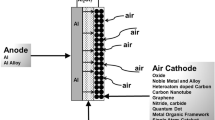Abstract
Thermal analysis of the binary system (Al(NO3)3)–(Cu(NO3)2) of different ratios was performed by using differential scanning calorimetry and thermogravimetric analysis. The eutectic temperature of the binary salt mixture was determined to be 65 °C. Moreover, the degradation temperature, specific heat, latent heat of fusion and thermal stability were reported, respectively. Further, this work focuses on synthesising low-temperature salt mixtures comprised of aluminium nitrate non-hydrate (Al(NO3)3) and copper nitrate hydrate (Cu(NO3)2) of varying compositions (60:40, 50:50, 55:45 and 57.5:42.5), respectively, which are optimised using Design of Expert v13. The performance of the binary salt mixture was determined from the results obtained from thermal stability measurements after the exposure of salt mixture to 120 h at a higher temperature. The results showed that the novel binary molten salt mixtures exhibit decomposition at 215 °C and the latent heat was found to increase from 17.7 to 20.73 J g−1 with the increase in aluminium nitrate composition with excellent repeatability after three sets of experiments. The average specific heat of binary molten salt mixture was observed from 2.73 to 2.13 J g−1 K−1. The optimal molar ratio of binary molten salts is found to be 60:40 (Al/Cu) from the obtained results. Field emission scanning electron microscopy and energy-dispersive X-ray showed a uniform distribution of both the salts in the mixture. The average specific heat of the optimal molar ratio was 21.8% higher compared to other molar ratios, indicating the most promising material to be used in solar applications.







Similar content being viewed by others
References
Bellos E, Tzivanidis C. A review of concentrating solar thermal collectors with and without nanofluids. J Therm Anal Calorim. 2019;135(1):763–86.
Esfe MH, Saedodin S, Yan W-M, Afrand M, Sina N. Study on thermal conductivity of water-based nanofluids with hybrid suspensions of CNTs/Al2O3 nanoparticles. J Therm Anal Calorim. 2016;124(1):455–60.
Srivastva U, Malhotra R, Kaushik S. Review of heat transport properties of solar heat transfer fluids. J Therm Anal Calorim. 2017;130(2):605–21.
Wu Y-T, Ying L, Lu Y-W, Wang H-F. Novel low melting point binary nitrates for thermal energy storage applications. Sol Energy Mater Sol Cells. 2017;164:114–21.
Li Y, Chen X, Wu Y, Lu Y, Zhi R, Wang X, et al. Experimental study on the effect of SiO2 nanoparticle dispersion on the thermophysical properties of binary nitrate molten salt. Sol Energy. 2019;183:776–81.
Hu Y, He Y, Zhang Z, Wen D. Enhanced heat capacity of binary nitrate eutectic salt-silica nanofluid for solar energy storage. Sol Energy Mater Sol Cells. 2019;192:94–102.
Chen X, Wu Y-T, Wang X, Ma C-F. Experimental study on thermophysical properties of molten salt nanofluids prepared by high-temperature melting. Sol Energy Mater Sol Cells. 2019;191:209–17.
Chen X, Wu Y-T, Lu Y-W, Ma C-F. Effect of nanoparticle dispersion on enhancing the specific heat capacity of quaternary nitrate for solar thermal energy storage application. Sol Energy Mater Sol Cells. 2016;157:808–13.
Shin D, Banerjee D. Specific heat of nanofluids synthesized by dispersing alumina nanoparticles in alkali salt eutectic. Int J Heat Mass Transf. 2014;74:210–4.
Jung S. Numerical and experimental investigation of inorganic nanomaterials for thermal energy storage (TES) and concentrated solar power (CSP) applications. College Station: Texas A & M University; 2012.
Myers PD, Goswami DY, Stefanakos E. Molten salt spectroscopy for quantification of radiative absorption in novel metal chloride-enhanced thermal storage media. J Sol Energy Eng. 2015;137(4):041002.
Zhao C, Wu Z. Thermal property characterization of a low melting-temperature ternary nitrate salt mixture for thermal energy storage systems. Sol Energy Mater Sol Cells. 2011;95(12):3341–6.
Suresh S, Venkitaraj K, Selvakumar P, editors. Synthesis, characterisation of Al2O3-Cu nano composite powder and water based nanofluids. In: Advanced materials research. Trans Tech Publ.; 2011.
Ahmad NNB, Yunos NB, Muhammad WNABW, Mohamad MNAB, Yusof FB, editors. Effect of lithium nitrate and calcium nitrate composition on the thermal properties of quaternary molten salts mixture for heat transfer application. Journal of Physics: Conference Series; 2017: IOP Publishing.
Wang T, Mantha D, Reddy RG. Novel low melting point quaternary eutectic system for solar thermal energy storage. Appl Energy. 2013;102:1422–9.
Tiznobaik H, Shin D. Enhanced specific heat capacity of high-temperature molten salt-based nanofluids. Int J Heat Mass Transf. 2013;57(2):542–8.
Tiznobaik H, Shin D. Experimental validation of enhanced heat capacity of ionic liquid-based nanomaterial. Appl Phys Lett. 2013;102(17):173906.
Gordon S, Campbell C. Differential thermal analysis of inorganic compounds. Anal Chem. 1955;27(7):1102–9.
Wendlandt W. Thermal decomposition of inorganic compounds. II. Metal nitrates. Tex J Sci. 1958;10:392–8.
Marote P, Matei C, Sigala C, Deloume J. Influence of spectator ions on the reactivity of divalent metal salts in molten alkali metal nitrates: morphology of the resulting metal oxides. Mater Res Bull. 2005;40(1):1–11.
Jo B, Banerjee D, editors. Interfacial thermal resistance between a carbon nanoparticle and molten salt eutectic: effect of material properties, particle shapes and sizes. In: ASME/JSME 2011 8th thermal engineering joint conference. American Society of Mechanical Engineers Digital Collection; 2011.
Wang B-X, Zhou L-P, Peng X-F. Surface and size effects on the specific heat capacity of nanoparticles. Int J Thermophys. 2006;27(1):139–51.
Shin D, Banerjee D. Enhancement of specific heat capacity of high-temperature silica-nanofluids synthesized in alkali chloride salt eutectics for solar thermal-energy storage applications. Int J Heat Mass Transf. 2011;54(5–6):1064–70.
Acknowledgements
The authors would like to thank Taylor’s University Flagship Grant (TUFR/2017/001/01) for supporting this work and are grateful to TA instruments for their help and support.
Author information
Authors and Affiliations
Corresponding authors
Additional information
Publisher's Note
Springer Nature remains neutral with regard to jurisdictional claims in published maps and institutional affiliations.
Rights and permissions
About this article
Cite this article
Vaka, M., Walvekar, R., Khalid, M. et al. Low-melting-temperature binary molten nitrate salt mixtures for solar energy storage. J Therm Anal Calorim 141, 2657–2664 (2020). https://doi.org/10.1007/s10973-020-09683-y
Received:
Accepted:
Published:
Issue Date:
DOI: https://doi.org/10.1007/s10973-020-09683-y




